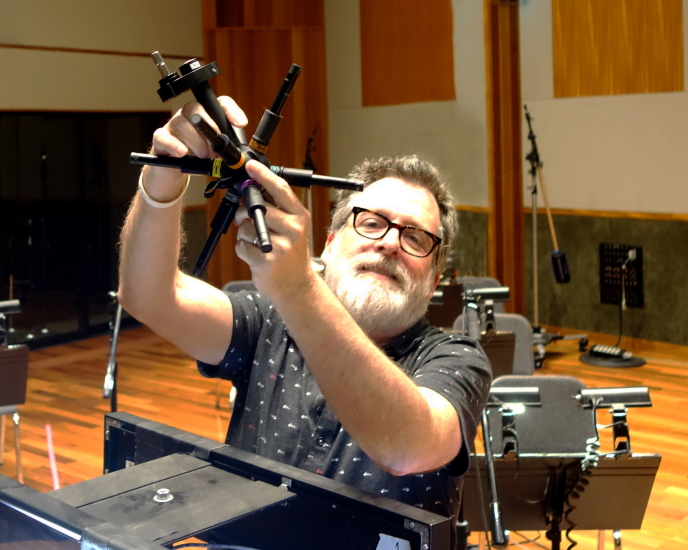Dave Way uses the Audio-Technica BP3600 Immersive Audio Microphone

Across a prolific recorded output over the last 20+ years, Iron & Wine (aka singer-songwriter Sam Beam) has captured the emotion and imagination of listeners with distinctly cinematic songs. Currently working with four-time GRAMMY-winning producer/engineer Dave Way (Fiona Apple, Ringo Starr, Phoebe Bridgers, Echo in the Canyon, Sheryl Crow, Pink, “Weird Al” Yankovic) at his Los Angeles-based Waystation Studio, Beam is laying down upcoming Iron & Wine tracks that will be released in stereo as well as a dedicated immersive Dolby Atmos® release, the latter benefiting from deployment of the BP3600 Immersive Audio Microphone from Audio-Technica, a leading innovator in transducer technology for over 60 years.
“All the recording was done here at the Waystation Studio with the exception of the string section date we did at Silent Zoo Studios in Glendale, CA,” stated Way. “I recently read about A-T’s new 3600 Immersive Audio Microphone and figured that would be perfect to capture strings. Doing strings for an Atmos mix usually involves putting up more distant mics and using dedicated ambient room mics to spread out the image, but it doesn’t really deal with the heights in a way that are coincident and timed in a way that is realistic,” commented Way. “After looking at the 3600, I immediately thought, ‘Wow, this looks like something that could be great for many things, but definitely for strings or other ensembles in a big room, and perhaps even something in a smaller room. And I was intrigued by applications that it had already been used for, which were sporting events, capturing ambience and crown audio, etc.”
Silent Zoo Studios, formally The Bridge Recording, is a renowned L.A. scoring stage that features a 1750 square-foot live room (big enough for a large orchestra), adjoining isolation booths and a spacious 875 square-foot control room with a 96-channel Neve VSP Legend console. On hand at Silent Zoo for the session with the 26-piece string section were artist Sam Beam, string arranger Paul Cartwright, vintage equipment specialist/engineer Dave Boucher and, of course, at the recording console, Way, who has been on the cutting edge of immersive recording and mixing for years. He received a GRAMMY nomination, for “Best Immersive Audio Album,” for his work as immersive audio co-producer on the 2019 album The Savior by A Bad Think, and has provided Atmos mixes for a wide-range of artists including Victoria Monet, Starrah, X frontman John Doe and Maroon 5. Most recently he engineered an Atmos-remixed version of Joe Satriani’s pivotal LP Surfing With The Alien.
Way went into the session highly optimistic about what the A-T BP3600 could deliver and says the results justified his enthusiasm. “I was excited about putting the BP3600 where the Decca Tree would normally go, which is basically above the conductor,” he elaborates. “We put up our normal kind of mic array – the Decca Tree and spot mics – as well as the BP3600. I had additional assistance for mic placement from David Boucher (a great engineer who does a lot of film scores). We just set up as you normally would for a string date, but rather than putting up extra ambient mics up for Atmos, we ran each of the 3600’s eight elements into eight channels of the Neve.” During the string date, said Way, “I was only monitoring in stereo, and one of my biggest concerns was how it was going to fold down to stereo. And when I solo’d it up, I instantly knew that it sounded great. Even though I wasn’t listening in any kind of surround format, let alone Atmos, that it sounded great in stereo was a great sign to me. When I got back to the Waystation, I immediately put up the tracks through the Dolby renderer and spread things out as they’re supposed to be with the height speakers, and it sounded incredible. When I was mixing, I used a blend of the 3600 and my spot mics and my Decca Tree and the other room mics and then Sam walked in and said, ‘Wow.’ He was blown away. When I played it for Paul a few nights later, he said, ‘This is what it sounds like when I’m playing in the room.’ I took that as confirmation that we were really on to something special.”
Way continues, “The thing that impressed me the most when I was listening to playback at the Waystation, was really hearing the focus of the imaging between the front and back, it felt like you were in the tracking room. It was very natural, just the way we normally hear things. It’s all about phase and coherency, which is exactly what I was hoping for. You can replicate that by using lots more room mics, where you can capture the sound of the room, but the coherency of the phase between the backs (and also in terms of this mic, the heights) – that’s kind of the key. 5.1 arrays have been around for a long time, and they’re very realistic for that, but they don’t include the height speakers. And it’s been kind of common for years now to have a 5.1 miking system then just selecting a couple of room mics to use as heights. There are different ways to do this, but none of them have a coincident center like the BP3600, which is very important, and that’s what drew me to it. It’s all coming from a very single source. It’s a very impressive microphone.”
 How to resolve AdBlock issue?
How to resolve AdBlock issue?